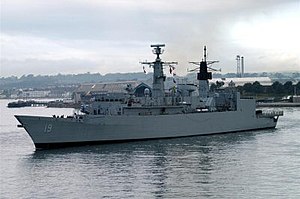Chilean frigate Almirante Williams (FF-19)
 The Chilean Navy's Almirante Williams
| |
| History | |
|---|---|
| Name | Sheffield |
| Namesake | Sheffield |
| Builder | Swan Hunter, Tyne and Wear, United Kingdom |
| Laid down | 29 March 1984 |
| Launched | 26 March 1986 |
| Commissioned | 26 July 1988 |
| Decommissioned | 5 November 2002 |
| Identification | Pennant number: F96 |
| Motto |
|
| Nickname(s) | Shiny Sheff |
| Fate | Sold to Chile |
| Name | Almirante Williams |
| Commissioned | 4 September 2003 |
| Identification | Pennant number: FF-19 |
| Status | In active service |
| General characteristics | |
| Class and type | Type 22 frigate |
| Displacement | 4,900 tons |
| Length | 148.2 m (486 ft 3 in) |
| Beam | 14.7 m (48 ft 3 in) |
| Draught | 6.4 m (21 ft 0 in) |
| Speed |
|
| Complement | 250 |
| Sensors and processing systems |
|
| Electronic warfare & decoys | In Chilean Navy service Terma SKWS |
| Armament |
|
| Aircraft carried |
|
Almirante Williams is a Type 22 frigate in service with the Chilean Navy. It entered service with the British Royal Navy in 1988 with the name HMS Sheffield, and served with the Royal Navy until 2002. Initially it was meant to be called Bruiser, but was named Sheffield in honour of the previous Sheffield, a Type 42 destroyer sunk in the Falklands War. In 2003, the vessel was acquired by the Chilean Navy and renamed Almirante Williams.
History
Sheffield was launched on 26 March 1986, by Swan Hunter, Tyne and Wear, United Kingdom, and named by Mrs Susan Stanley, wife of the then Armed Forces Minister. The ship was commissioned at Hull on 26 July 1988. Several crewmen of the previous Sheffield were at the launch. A specially minted Sheffield coin was placed in the keel at the keel-laying ceremony on 29 March 1984.
In late 1998, Sheffield provided assistance after
Sheffield attended the August Bank Holiday 28–30 August 1999 Navy Days at HMNB Devonport, berthed with Sutherland, Somerset, Monmouth, Montrose, Manchester, Illustrious, Campbeltown, Trafalgar, Triumph and RFA Argus.

May 2000 saw Sheffield deployed on an eight-week deployment into the
8 February 2001 saw Sheffield, under Commander
5 February 2002 saw Sheffield deployed to the
On 11 October 2002 Sheffield visited Kingston upon Hull one last time so that she could be visited by the people of her namesake city of Sheffield.[8]
Sheffield was decommissioned on 4 November 2002.
Chilean service
Sheffield was acquired by Chile on 5 September 2003 and renamed Almirante Williams in honour of Vice Admiral Juan Williams Rebolledo, who was Commander of the Chilean Fleet at the beginning of the War of the Pacific.[12]
Since its commissioning, Williams has served as part of the Chilean Fleet, where after various modernization projects carried out in the country, it serves as the flagship of this naval force.[12]
She received a major refit in 2008, which saw her weapons fit change to:
- 1 x 76mm gun
- 2 x 20mm Oerlikon cannon
- 8 x Harpoon anti-ship missiles
- 2 x Barak 1point defence systems
- 2 x triple 324mm ASW torpedo tubes
- Embarkation of 1 x SH-32 Cougar ASW helicopter[12]
The new equipment was retrieved from decommissioned County-class destroyers.[citation needed]
The main roles of this unit, with its base port in Valparaíso, are the search and attack of submarines, surface combat and support in the event of catastrophes and emergencies. It also has the capacity to transport a Cougar helicopter.[12]
Notes
- ^ "HMS Ocean returns from trials in the west indies". Royal Navy. 11 December 1998.
- ^ "Sir Tristram – finally home after hurricane relief operations". Royal Navy. 17 December 1998.
- ^ "HMS Sheffield returns from the Baltic sea". Royal Navy. 25 July 2000.
- ^ "HMS Sheffield bound for the Caribbean". Royal Navy. 7 February 2001.
- ^ "HMS Sheffield deployment update". Royal Navy. 20 June 2001.
- ^ "HMS Sheffield to take over role as NATO flagship". Royal Navy. 7 February 2002.
- ^ "HMS Sheffield Lynx helps Spanish submarine". Royal Navy. 28 February 2002.
- ^ "HMS Sheffield's farewell visit". BBC. 11 October 2002.
- ^ "Withdrawal from service of HMS Sheffield". Royal Navy. 9 October 2002.
- ^ "HMS Sheffield is decommissioned at Devonport". Royal Navy. 12 November 2002.
- ^ "HMS Sheffield is decommissioned". BBC. 4 November 2002.
- ^ a b c d Chilean Navy, FF-19 "Almirante Williams", retrieved 7 December 2023
References
- HMS Sheffield Type 22 Frigate (Batch 2A) guide. Directorate of Public Relations (Royal Navy). Printed in UK for HMSO by Roman Press Ltd, Bournemouth. Crown Copyright 1994, London.
- Devonport Navy Days guide 1999
Further reading
- Lofthouse, Alistair (1998). Shiny Sheff – The Story of Sheffield's Fighting Ships. Northern Map Distributors. ISBN 1-901587-03-7. .
External links
- HMS Sheffield Association Website
- Sources for the study of HMS Sheffield, Sheffield City Council's Libraries and Archives

